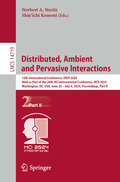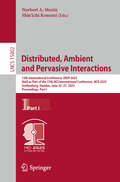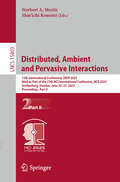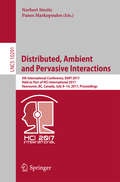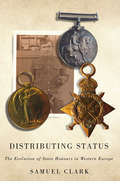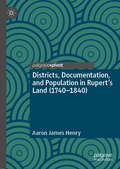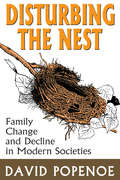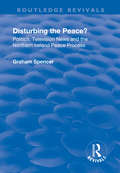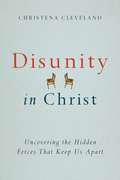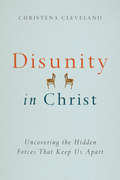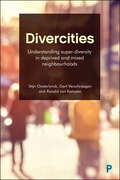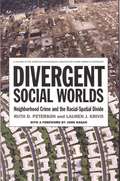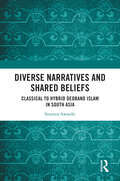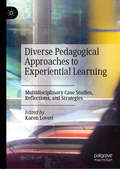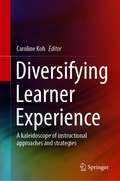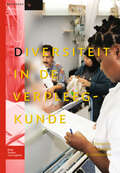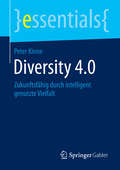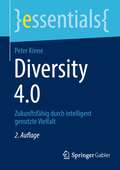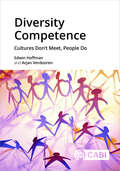- Table View
- List View
Distributed, Ambient and Pervasive Interactions: 12th International Conference, DAPI 2024, Held as Part of the 26th HCI International Conference, HCII 2024, Washington, DC, USA, June 29 – July 4, 2024, Proceedings, Part I (Lecture Notes in Computer Science #14718)
by Shin’ichi Konomi Norbert A. StreitzThis book constitutes the refereed proceedings of the 12th International Conference on Distributed, Ambient and Pervasive Interactions, DAPI 2024, held as part of the 26th International Conference on Human-Computer Interaction, HCI International 2024 (HCII 2024), was held as a hybrid event in Washington DC, USA, during June/July 2024. The total of 1271 papers and 309 posters included in the HCII 2023 proceedings was carefully reviewed and selected from 5108 submissions. The DAPI conference addressed approaches and objectives of information, interaction, and user experience design for DAPI Environments as well as their enabling technologies, methods, and platforms, and relevant application areas. The DAPI 2024 conference covered topics addressing basic research questions and technology issues in the areas of new modalities, immersive environments, smart devices, and much more.
Distributed, Ambient and Pervasive Interactions: 12th International Conference, DAPI 2024, Held as Part of the 26th HCI International Conference, HCII 2024, Washington, DC, USA, June 29 – July 4, 2024, Proceedings, Part II (Lecture Notes in Computer Science #14719)
by Shin’ichi Konomi Norbert A. StreitzThis book constitutes the refereed proceedings of the 12th International Conference on Distributed, Ambient and Pervasive Interactions, DAPI 2024, held as part of the 26th International Conference on Human-Computer Interaction, HCI International 2024 (HCII 2024), was held as a hybrid event in Washington DC, USA, during June/July 2024. The total of 1271 papers and 309 posters included in the HCII 2023 proceedings was carefully reviewed and selected from 5108 submissions. The DAPI conference addressed approaches and objectives of information, interaction, and user experience design for DAPI Environments as well as their enabling technologies, methods, and platforms, and relevant application areas. The DAPI 2024 conference covered topics addressing basic research questions and technology issues in the areas of new modalities, immersive environments, smart devices, and much more.
Distributed, Ambient and Pervasive Interactions: 13th International Conference, DAPI 2025, Held as Part of the 27th HCI International Conference, HCII 2025, Gothenburg, Sweden, June 22–27, 2025, Proceedings, Part I (Lecture Notes in Computer Science #15802)
by Shin’ichi Konomi Norbert A. StreitzThis two-volume set LNCS 15802-15803 constitutes the refereed proceedings of the 13th International Conference on Distributed, Ambient and Pervasive Interactions, DAPI 2025, held as part of the 27th International Conference on Human-Computer Interaction, HCII 2025, in Gothenburg, Sweden, during June 22-27, 2025. The total of 1430 papers and 355 posters included in the HCII 2025 proceedings was carefully reviewed and selected from 7972 submissions.The two volumes cover the following topics:Part I: Designing and developing intelligent environments; and user experience in intelligent environments.Part II: Smart cities and public spaces; eXtended reality and robots in intelligent environments; and wellbeing in intelligent environments.
Distributed, Ambient and Pervasive Interactions: 13th International Conference, DAPI 2025, Held as Part of the 27th HCI International Conference, HCII 2025, Gothenburg, Sweden, June 22–27, 2025, Proceedings, Part II (Lecture Notes in Computer Science #15803)
by Shin’ichi Konomi Norbert A. StreitzThis two-volume set LNCS 15802-15803 constitutes the refereed proceedings of the 13th International Conference on Distributed, Ambient and Pervasive Interactions, DAPI 2025, held as part of the 27th International Conference on Human-Computer Interaction, HCII 2025, in Gothenburg, Sweden, during June 22-27, 2025. The total of 1430 papers and 355 posters included in the HCII 2025 proceedings was carefully reviewed and selected from 7972 submissions.The two volumes cover the following topics:Part I: Designing and developing intelligent environments; and user experience in intelligent environments.Part II: Smart cities and public spaces; eXtended reality and robots in intelligent environments; and wellbeing in intelligent environments.
Distributed, Ambient and Pervasive Interactions: 5th International Conference, DAPI 2017, Held as Part of HCI International 2017, Vancouver, BC, Canada, July 9–14, 2017, Proceedings (Lecture Notes in Computer Science #10291)
by Panos Markopoulos Norbert StreitzThis book constitutes the refereed proceedings of the 5th International Conference on Distributed, Ambient and Pervasive Interactions, DAPI 2013, held as part of the 15th International Conference on Human-Computer Interaction, HCII 2013, held in Las Vegas, USA in July 2013, jointly with 12 other thematically similar conferences. The total of 1666 papers and 303 posters presented at the HCII 2013 conferences was carefully reviewed and selected from 5210 submissions. These papers address the latest research and development efforts and highlight the human aspects of design and use of computing systems. The papers accepted for presentation thoroughly cover the entire field of human-computer interaction, addressing major advances in knowledge and effective use of computers in a variety of application areas. The total of 54 contributions was carefully reviewed and selected for inclusion in the DAPI proceedings. The papers are organized in the following topical sections: natural interaction; context-awareness in smart and intelligent environments; design and evaluation of smart and intelligent environments; smart cities; multi-user, group and collaborative interaction; smart everyday living and working environments.
Distributed, Collaborative, and Federated Learning, and Affordable AI and Healthcare for Resource Diverse Global Health: Third MICCAI Workshop, DeCaF 2022, and Second MICCAI Workshop, FAIR 2022, Held in Conjunction with MICCAI 2022, Singapore, September 18 and 22, 2022, Proceedings (Lecture Notes in Computer Science #13573)
by M. Jorge Cardoso Shadi Albarqouni Spyridon Bakas Islem Rekik Bennett Landman Nicola Rieke Holger Roth Daguang Xu Bishesh Khanal Debdoot Sheet Xiaoxiao Li Sophia Bano Chen QinThis book constitutes the refereed proceedings of the Third MICCAI Workshop on Distributed, Collaborative, and Federated Learning, DeCaF 2022, and the Second MICCAI Workshop on Affordable AI and Healthcare, FAIR 2022, held in conjunction with MICCAI 2022, in Singapore in September 2022. FAIR 2022 was held as a hybrid event.DeCaF 2022 accepted 14 papers from the 18 submissions received. The workshop aims at creating a scientific discussion focusing on the comparison, evaluation, and discussion of methodological advancement and practical ideas about machine learning applied to problems where data cannot be stored in centralized databases or where information privacy is a priority. For FAIR 2022, 4 papers from 9 submissions were accepted for publication. The topics of the accepted submissions focus on deep ultrasound segmentation, portable OCT image quality enhancement, self-attention deep networks and knowledge distillation in low-regime setting.
Distributing Status: The Evolution of State Honours in Western Europe
by Samuel ClarkHonorific rewards are all about status and illustrate status processes in a way that few other social phenomena do. Why do we have so many honorific awards and prizes? Although they are a major feature of modern societies, they have received little scholarly attention. Samuel Clark argues that answering this question requires a separate historical analysis of different awards and prizes. He presents a comprehensive explanation of the origins and evolution of state honours in the British Isles, France, and the Low Countries. Examining cultural, social, and political changes that led to the massive growth in state honours and shaped their characteristics, Distributing Status also demonstrates their functions as instruments of cultural power, collective power, disciplinary power, and status power. Clark supports his conclusions with a cross-cultural statistical analysis of twenty societies. Lucid and logical, Distributing Status explicates an important historical change in Western Europe while at the same time contributing to several bodies of sociological literature, including evolutionary theory, theories of collective action, writings on discipline in modern societies, and studies of status processes.
Distributive Justice and Access to Advantage
by Alexander KaufmanG. A. Cohen was one of the world's leading political theorists. He was noted, in particular, for his contributions to the literature of egalitarian justice. Cohen's classic writings offer one of the most influential responses to the currency of the egalitarian justice question – the question, that is, of whether egalitarians should seek to equalize welfare, resources, opportunity, or some other indicator of well-being. Underlying Cohen's argument is the intuition that the purpose of egalitarianism is to eliminate disadvantage for which it is inappropriate to hold the person responsible. His argument therefore focuses on the appropriate role of considerations regarding responsibility in egalitarian judgment. This volume comprises chapters by major scholars addressing and responding both to Cohen's account of the currency of egalitarian justice and its practical implications and to Cohen's arguments regarding the appropriate form of justificatory arguments about justice.
Districts, Documentation, and Population in Rupert’s Land (1740–1840)
by Aaron James HenryThis book interrogates how districts were used in British North America to inspect, and document indigenous people by the Hudson’s Bay Company (HBC). In particular, it examines how the HBC utilized districts to create a political geography that allowed for closer surveillance of indigenous people and stabilized debt. An initial examination of how the district was used to rework earlier 18th-century conducts of observation into the more ordered and spatially limited regime of inspection is undertaken, followed by an investigation of how the district became central to the HBC’s efforts to limit the movement of indigenous people, individualize hunters, and spur ‘industriousness’. The book points to how districts became key to a number of colonial projects, laying the infrastructure for the modern reserve system in Canada. In this sense, the book provides a critical genealogy of how the command of space and social vision shaped Canada’s colonial geography.
Disturbing the Nest: Family Change and Decline in Modern Societies
by David PopenoeDisturbing the Nest assesses the future of the family as an institution through an historical and comparative analysis of the nature, causes, and social implications of family change in advanced western societies such as the United States, New Zealand, and Switzerland by focusing on the one society in which family decline is found to be the greatest, Sweden. The founding of the modern Swedish welfare state was based in large part on the belief that it was necessary for the state to intervene in society in order to improve the situation of the family. Of great concern was the low birthrate, which was seen as a threat to the very survival of Swedes as a national population group. The Social Democrats pioneered welfare measures that aimed to strengthen the family, to alleviate its worst trials and tribulations, and to make possible harmonious living. With the Social Democrats remaining in power continuously until 1976, a period of almost forty-five years, Sweden went on to implement governmental "family policies" that are among the most comprehensive (and expensive) in the world. In view of this major policy goal of family improvement, the actual situation of the Swedish family today presents a genuine irony; some have claimed that Swedish welfare state policies have had consequences that are the opposite of those originally intended. Comparing contemporary Swedish family patterns with those of other advanced nations, one finds a very high family dissolution rate, probably the highest in the Western world, and a high percentage of single-parent, female headed families. Even marriage seems to have fallen increasingly out of favor, with Sweden having the lowest marriage rate and latest age of first marriage, and the highest rate of children born out-of-wedlock. The early pronatalist aspirations of the Swedish government have been spectacularly unsuccessful, as Sweden continues to have one of the world's lowest birthrates and smallest average family sizes.
Disturbing the Peace? (Routledge Revivals)
by Graham SpencerThis title was first published in 2000. This study explores how the national television news media has covered the Northern Ireland peace process and its role within the politics of that process. It is particularly concerned with how news and politics interacted and how this affected the promotion and development of peace.
Disunity in Christ: Uncovering the Hidden Forces That Keep Us Apart
by Christena ClevelandDespite Jesus' prayer that all Christians "be one," divisions have been epidemic in the body of Christ from the beginning to the present. We cluster in theological groups, gender groups, age groups, ethnic groups, educational and economic groups. We criticize freely those who disagree with us, don't look like us, don't act like us and don't even like what we like. Though we may think we know why this happens, Christena Cleveland says we probably don't. In this eye-opening book, learn the hidden reasons behind conflict and divisions. Cleveland brings to bear the latest studies and research on the unseen dynamics at work that tend to separate us from others. Learn why Christians who have a heart for unity have such a hard time actually uniting. The author provides real insight for ministry leaders who have attempted to build bridges across boundaries. Here are the tools we need to understand how we can overcome the hidden forces that divide us.
Disunity in Christ: Uncovering the Hidden Forces that Keep Us Apart
by Christena ClevelandLeadership Journal2014 Readers' Choice Awards Honorable MentionWhy I think all my friends are unique but those in other groups are all the sameWhy little differences often become big sources of conflictWhy categorizing others is often automatic and helpful but can also have sinister side effectsWhy we are so often victims of groupthink and how we can avoid itWhy women think men are judging them more negatively than men actually are, and vice versaWhy choices of language can actually affect unity
Divercities: Understanding Super-Diversity in Deprived and Mixed Neighbourhoods
by Stijn Oosterlynck, Gert Verschraegen and Ronald van KempenHow do people deal with diversity in deprived and mixed urban neighbourhoods? This edited collection provides a comparative international perspective on superdiversity in cities, with explicit attention given to social inequality and social exclusion on a neighbourhood level. Although public discourses on urban diversity are often negative, this book focuses on how residents actively and creatively come and live together through micro-level interactions. By deliberately taking an international perspective on the daily lives of residents, the book uncovers the ways in which national and local contexts shape living in diversity. The book will be a valuable resource for researchers and students of poverty, segregation and social mix, conviviality, the effects of international migration, urban and neighbourhood policies and governance, multiculturality, social networks, social cohesion, social mobility, and super-diversity.
Divergent Social Worlds: Neighborhood Crime and the Racial-Spatial Divide
by Ruth D. Peterson Lauren J. KrivoMore than half a century after the first Jim Crow laws were dismantled, the majority of urban neighborhoods in the United States remain segregated by race. The degree of social and economic advantage or disadvantage that each community experiences--particularly its crime rate--is most often a reflection of which group is in the majority. As Ruth Peterson and Lauren Krivo note in Divergent Social Worlds, "Race, place, and crime are still inextricably linked in the minds of the public. " This book broadens the scope of single-city, black/white studies by using national data to compare local crime patterns in five racially distinct types of neighborhoods. Peterson and Krivo meticulously demonstrate how residential segregation creates and maintains inequality in neighborhood crime rates. Based on the authors' groundbreaking National Neighborhood Crime Study (NNCS), Divergent Social Worlds provides a more complete picture of the social conditions underlying neighborhood crime patterns than has ever before been drawn. The study includes economic, social, and local investment data for nearly nine thousand neighborhoods in eighty-seven cities, and the findings reveal a pattern across neighborhoods of racialized separation among unequal groups. Residential segregation reproduces existing privilege or disadvantage in neighborhoods--such as adequate or inadequate schools, political representation, and local business--increasing the potential for crime and instability in impoverished non-white areas yet providing few opportunities for residents to improve conditions or leave. And the numbers bear this out. Among urban residents, more than two-thirds of all whites, half of all African Americans, and one-third of Latinos live in segregated local neighborhoods. More than 90 percent of white neighborhoods have low poverty, but this is only true for one quarter of black, Latino, and minority areas. Of the five types of neighborhoods studied, African American communities experience violent crime on average at a rate five times that of their white counterparts, with violence rates for Latino, minority, and integrated neighborhoods falling between the two extremes. Divergent Social Worlds lays to rest the popular misconception that persistently high crime rates in impoverished, non-white neighborhoods are merely the result of individual pathologies or, worse, inherent group criminality. Yet Peterson and Krivo also show that the reality of crime inequality in urban neighborhoods is no less alarming. Separate, the book emphasizes, is inherently unequal. Divergent Social Worlds lays the groundwork for closing the gap--and for next steps among organizers, policymakers, and future researchers. A Volume in the American Sociological Association's Rose Series in Sociology
Diverging Destinies
by James M. Raymo Miho IwasawaThe overarching objective of this book is to summarize, extend, and update previous research on educational differences in family behavior in Japan. This is the first comprehensive treatment of the subject and the first to evaluate family differentials in Japan in the context of ideas articulated in research on "diverging destinies" and "patterns of disadvantage" as part of the second demographic transition. Much of the previous work in this area has been conducted by the authors (Raymo and Iwasawa), and the longer format of this book allows us to reexamine a wide range of family outcomes using newer data and to provide a thorough and systematic evaluation. The text uses multiple sources of data that cover a period of rapid family change (1970s through 2010s) to describe trends in educational differences in a wide range of family behaviors linked to the well-being of both parents and children. Descriptive analyses provide an overview of period and cohort trends in educational differences in age at first marriage, assortative mating, cohabitation, bridal pregnancy, divorce, remarriage, age at first birth, unintended childbearing, single motherhood, maternal employment, and family-related attitudes. Multivariate analyses provide insights into the processes underlying observed educational differences in family behavior. Patterns of educational differences in family behavior in Japan are evaluated with reference to findings from related research in the United States and other low-fertility Western societies.
Diverse Narratives and Shared Beliefs: Classical to Hybrid Deoband Islam in South Asia
by Soumya AwasthiThis book delves into the intricate tapestry of Deoband Islam in India, Pakistan, and Afghanistan. Challenging simplistic narratives, it unveils the nuanced reality of Deoband Islam, revealing a diverse range of perspectives within the movement. It illuminates the movement's historical, social, and philosophical dimensions. It explores the movement's relationship with societal transformation and communal identity and its impact on the geopolitical dynamics of South Asia.The book offers a distinctive perspective on the Deoband school of thought in Islam by systematically categorising it into three distinct regional variants, each reflecting the unique socio-political context of its environment. The focus is on the Deoband school of thought, a strand within Sunni Islam that adheres to the philosophical framework of Ashari Maturidi. Critically examining its teachings uncovers the complexities and contradictions that shape Deobandi's thought, challenging popular assumptions and providing a fresh understanding. It also highlights the voices of Deobandi scholars and organisations who unequivocally denounce terrorism and actively work to counter radicalisation. Acknowledging their efforts, the book underscores the potential for dialogue and cooperation in promoting peace and understanding.With its comprehensive approach and thought-provoking analysis, this book is essential for scholars, policymakers, political science departments, theology, sociology, international relations, security studies, and South Asian studies.
Diverse Pedagogical Approaches to Experiential Learning: Multidisciplinary Case Studies, Reflections, and Strategies
by Karen LovettThis edited collection offers a unique multidisciplinary perspective into the many factors that go into designing, facilitating, expanding, and assessing experiential learning (EL) from the perspective of faculty and staff educators. The editor and contributors bring decades of expertise with different forms of EL, including community-engaged learning, education abroad, internships, and more. Chapters offer case studies and reflections which highlight personal experiences and anecdotes which illuminate the realities of experiential teaching and learning. Through these stories and narratives, readers may better understand what doing EL entails on an everyday basis—both on a local and global scale—and learn how to enhance support and resources for experiential educators on college and university campuses.
Diverse Voices in Chinese Translation and Interpreting: Theory and Practice (New Frontiers in Translation Studies)
by Riccardo Moratto Martin WoeslerThis book presents a thoughtful and thorough account of diverse studies on Chinese translation and interpreting (TI). It introduces readers to a plurality of scholarly voices focusing on different aspects of Chinese TI from an interdisciplinary and international perspective. The book brings together eighteen essays by scholars at different stages of their careers with different relationships to translation and interpreting studies. Readers will approach Chinese TI studies from different standpoints, namely socio-historical, literary, policy-related, interpreting, and contemporary translation practice. Given its focus, the book benefits researchers and students who are interested in a global scholarly approach to Chinese TI. The book offers a unique window on topical issues in Chinese TI theory and practice. It is hoped that this book encourages a multilateral, dynamic, and international approach in a scholarly discussion where, more often than not, approaches tend to get dichotomized. This book aims at bringing together international leading scholars with the same passion, that is delving into the theoretical and practical aspects of Chinese TI.
Diversifying Learner Experience: A kaleidoscope of instructional approaches and strategies
by Caroline KohThis book brings together strategies and innovations that educators from diverse educational contexts have conceptualized and implemented to cater to differences in academic ability, as well as in other domains such as psychosocial contexts and developmental needs. The emergence of IT and new technologies have altered the educational landscape and opened a multitude of opportunities for diverse modes of instruction catering to diverse student populations.The book addresses the gap in the literature with evidence-based reports of innovative strategies and approaches that are grounded in educational research. It identifies student differences in terms of academic ability and also, with regard to their cultural and social background, their developmental and psycho-emotional needs. It examines how new technologies are used in instructional approaches and how these innovative strategies diversify learner experiences. The book is a valuable resource to practitioners, researchers and educational administrators.
Diversiteit in de verpleegkunde
by P. Esterhuizen A.U. Kuckert-PanderVerpleegkundigen staan dicht bij mensen. Inlevingsvermogen en mensenkennis zijn onmisbaar voor goede observaties, klinisch redeneren of voor het kunnen geven van steun. Hoe herken je als verpleegkundige diversiteit en hoe geef je dat een goede plek in je handelen? Dit boek maakt de complexiteit van het onderwerp ‘diversiteit’ zichtbaar en biedt tegelijkertijd handvatten. Het boek laat zien hoe belangrijk de dialoog met patiënten is en hoe een verpleegkundige kennis over groepskenmerken kan combineren met het oog hebben voor unieke eigenschappen. Op het eerste oog homogene groepen patiënten kunnen veel diversiteit bevatten. De auteurs benaderen het onderwerp ‘diversiteit’ vanuit verschillende perspectieven. De complexiteit van het onderwerp wordt hierdoor goed zichtbaar. Dat diversiteit centraal staat in dit boek is niet alleen te zien aan de titel, maar ook aan de diversiteit in de opbouw van hoofdstukken. Elk hoofdstuk kan op zichzelf gelezen worden. Drie hoofdstukken zijn in de Engelse taal geschreven. Niet alleen de opbouw en de taal van de hoofdstukken is divers, maar ook de auteurs zelf verschillen in leeftijd, geslacht, gezinssituatie, opleiding (verpleegkunde, culturele antropologie, sociologie, etc.) en woonplaats (Nederland, Duitsland, Groot-Brittannië, Amerika).
Diversities Old and New
by Steven VertovecDiversities Old and New provides comparative analyses of new urban patterns that arise under conditions of rapid, migration-driven diversification, including transformations of social categories, social relations and public spaces. Ethnographic findings in neighbourhoods of New York, Singapore and Johannesburg are presented.
Diversity 4.0: Zukunftsfähig durch intelligent genutzte Vielfalt (essentials)
by Peter KinneDas essential eröffnet neue Perspektiven für den Umgang mit sozio-kultureller Vielfalt in Organisationen. Es beleuchtet betriebswirtschaftlich-systemische Hintergründe, zeigt das Potenzial von Vielfalt zur Bewältigung von Komplexität, deckt Synergiepotenziale zwischen Diversity-, Qualitäts-, Innovations-, Marken- und Change-Management auf und liefert die Verbindung zu einer auf Ausgewogenheit basierenden, zukunftsorientierten Managementstrategie. Es beschreibt ein differenziertes Konzept, anhand dessen der Umgang mit Vielfalt zielorientiert geplant und so gesteuert werden kann, dass er nicht nur die Produktivität, sondern auch die Zukunftsfähigkeit von Organisationen verbessert.
Diversity 4.0: Zukunftsfähig durch intelligent genutzte Vielfalt (essentials)
by Peter KinneDas essential eröffnet neue Perspektiven für den Umgang mit sozio-kultureller Vielfalt in Organisationen. Es beleuchtet betriebswirtschaftlich-systemische Hintergründe, zeigt das Potenzial von Vielfalt zur Bewältigung von Komplexität, deckt Synergiepotenziale zwischen Diversity-, Qualitäts-, Innovations-, Marken- und Change-Management auf und liefert die Verbindung zu einer auf Ausgewogenheit basierenden, zukunftsorientierten Managementstrategie. Es beschreibt ein differenziertes Konzept, anhand dessen der Umgang mit Vielfalt zielorientiert geplant und so gesteuert werden kann, dass er nicht nur die Produktivität, sondern auch die Zukunftsfähigkeit von Organisationen verbessert.
Diversity Competence: Cultures Don’t Meet, People Do
by Dr Edwin Hoffman Arjan VerdoorenIn today's world many people live, learn and work in international and multicultural environments. Intercultural communication has become an important topic in many fields of work and study. Given the complexities of globalization, knowledge of cultures and cultural differences is rarely sufficient. In this book, interpersonal communication forms the point of departure: the meeting of people, not of cultures. The authors describe what diversity competence entails: which processes, challenges and skills are relevant in a 'superdiverse' world. They demonstrate how the TOPOI model offers an inclusive, communicative approach to analyzing and addressing potential miscommunication. - Addresses controversial topics frankly and clearly without being simplistic. - Discusses theory from several different fields. - Case studies provide practical examples and guidelines. - Companion website with extra case studies and study assignments. The target audience for Diversity Competence includes students, educators and professionals in the fields of communication and media, business, management and leadership, governance and international relations and cooperation.

